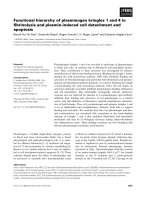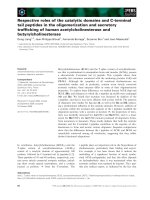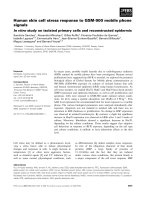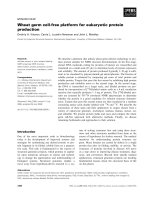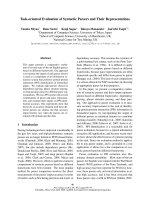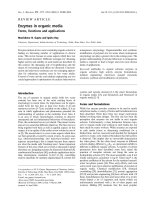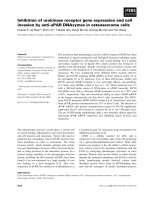Báo cáo khoa học: Acetylcholinesterase in cell adhesion, neurite growth and network formation pot
Bạn đang xem bản rút gọn của tài liệu. Xem và tải ngay bản đầy đủ của tài liệu tại đây (311.73 KB, 7 trang )
MINIREVIEW
Acetylcholinesterase in cell adhesion, neurite growth and
network formation
Laura E. Paraoanu and Paul G. Layer
Darmstadt University of Technology, Germany
Acetylcholinesterase – a protein with
many faces
Acetylcholinesterase (EC 3.1.1.7) is an enzyme that has
an indispensable role in synaptic transmission by cata-
lysing hydrolysis of the neurotransmitter acetylcholine.
This classical function of acetylcholinesterase is well
established, but its diverse localization in non-choliner-
gic and non-neural cells and tissues [1], and the diver-
sity of its molecular forms [2] strongly suggest
additional, ‘non-classical’ functions for acetylcholines-
terase. Many proteins, including enzymes, have been
found to have more than one function, e.g. functioning
as structural proteins in the lens of the eye, or binding
to DNA or RNA to regulate translation or transcrip-
tion [3]. However, there is currently no straightforward
method by which to identify which protein encoded by
a given genomic sequence has multiple functions. The
dogma one gene–one protein–one function no longer
holds true. For acetylcholinesterase, the idea that this
protein can serve several biological functions is now
accepted, functions that are primarily related to
morpho-regulation, adhesion, stress or pathological sit-
uations [1,4–6].
One way of achieving increased functional complexity
is via alternative splicing. To make things even more
complex, many proteins present unfolded components,
the function of which remains elusive. Sussman [7] sug-
gested that these unstructured molecular modules may
be used for various purposes, each one dependent on,
and ‘being structurally induced’ by, a given binding
partner. Although this hypothesis requires experimental
validation, for acetylcholinesterase it is clear that by
using different combinations of exons, a single ache gene
can yield several polypeptide products with different
C-termini. Three alternatively spliced isoforms of acetyl-
cholinesterase have been well established: the tetrameric
AChE-S isoform (‘S’, synaptic), the dimeric glycophos-
phatidylinositol-anchored AChE-E isoform, expressed
in blood (‘E’, erythrocytic) and the ‘read-through’
variant of acetylcholinesterase (AChE-R) [2]. These
acetylcholinesterase isoforms have the same enzymatic
Keywords
acetylcholinesterase; adhesion; co-opting
proteins; extracellular matrix; knock-out
mouse; neurite outgrowth; non-cholinergic
functions; laminin-1; retina; structural
interactions
Correspondence
L. E. Paraoanu, Darmstadt University of
Technology, Developmental Biology,
Schnittspahnstrasse 3, 64287 Darmstadt,
Germany
Fax: +49 6151 166548
Tel: +49 6151 166105
E-mail:
(Received 27 September 2007,
accepted 22 November 2007)
doi:10.1111/j.1742-4658.2007.06237.x
The expression of acetylcholinesterase is not restricted to cholinergically
innervated tissues and relates to both neurotransmission and multiple bio-
logical aspects, including neural development, stress response and neurode-
generative diseases. Therefore, the classical function of acetylcholinesterase
has to be distinguished from its non-classical, e.g. enzymatic from non-
enzymatic, functions. Here, the roles of acetylcholinesterase in cell adhe-
sion, promoting neurite outgrowth and neural network formation are
reviewed briefly, together with potential mechanisms to support these func-
tions. Part of these functions may depend on the structural properties of
acetylcholinesterase, for example, protein–protein interactions. Recent find-
ings have revealed that laminin-1 is an interaction partner for acetylcholin-
esterase. The binding of acetylcholinesterase to this extracellular matrix
component may allow cell-to-cell recognition, and also cell signalling via
membrane receptors. Studies using monolayer and 3D spheroid retinal cul-
tures, as well as the acetylcholinesterase-knockout mouse, have been instru-
mental in elaborating the non-classical functions of acetylcholinesterase.
618 FEBS Journal 275 (2008) 618–624 ª 2008 The Authors Journal compilation ª 2008 FEBS
activity but differ in their tissue specificity, developmen-
tal expression, multimeric assembly, membrane-associa-
tion patterns and cellular localization. Although
acetylcholinesterase is primarily expressed in the central
and peripheral nervous systems, different isoforms are
found in haematopoietic cells, osteoblasts, vascular
endothelial cells and leukocytes, and are induced in vari-
ous cell lines undergoing apoptosis [8–11]. Recently, the
existence of an acetylcholinesterase protein localized to
the nucleus has been documented [12], possibly indicat-
ing roles for acetylcholinesterase in angiogenesis and
tumour development. Variations in acetylcholinesterase
cellular localization, whether membrane-attached,
secreted, nuclear or cytoplasmic, have also led to the
detection of a variety of interaction partners for the
acetylcholinesterase protein (Table 1). Cytoplasmic
proteins like RACK [13], nuclear proteins like the trans-
criptional co-repressor C-terminal binding protein [14],
or b-amyloid [15] can interact with acetylcholinesterase,
and consequently may contribute to its functional
diversity. Another level of possible multifunctionality of
acetylcholinesterase has been introduced by reports on
aryl acylamidase as a developmentally regulated enzy-
matic side activity located on the acetylcholinesterase
protein [16].
Acetylcholinesterase and adhesion
There is good evidence that acetylcholinesterase plays
a ‘non-classical’ role as an adhesion protein. A molecu-
lar basis for this emerged following the detection of
a new class of proteins, cholinesterase-like adhesion
molecules [17,18]. This protein family includes the
Drosophila glutactin, neurotactin, gliotactin and the
mammalian neuroligins. These proteins are catalyti-
cally inactive, but their cholinesterase-like domain has
high sequence similarity with acetylcholinesterase and
also acts as a protein–protein interaction domain.
In all family members, these domains are found in the
extracellular space and may contribute to the forma-
tion of cellular junctions by binding to other extracel-
lular ligands. The existence of these proteins provided
a convincing reason to assume that acetylcholinesterase
itself may engage in protein–protein interactions.
It is striking that all cholinesterase-like adhesion
molecules display similar electrostatic characteristics
[17], presenting a typical ‘annular’ electrostatic motif
of negative potential around a zone that is homolo-
gous to the active-site gorge of acetylcholinesterase.
The biological significance of the electrostatic surface
potential of acetylcholinesterase is disputed [19].
Because it is known that electrostatic interactions
can facilitate target recognition via protein-complex
formation, the fact that all cholinesterase-like adhesion
molecules share similar electrostatic characteristics
strongly supports the notion that acetylcholinesterase
can function as an adhesive protein.
In vitro evidence for the adhesive functions of acetyl-
cholinesterase was provided by Sharma et al. [20] using
a microtitre-plate adhesion assay. By using an electri-
cal cell–subs trate impedance-sensing method, they
demonstrated that the level of cell–substratum adhe-
sion of neuroblastoma cells correlates directly with
their level of acetylcholinesterase expression. In neuro-
nal cells, and also in astrocytes and fibroblasts, acetyl-
cholinesterase may have morpho-regulatory roles.
There, acetylcholinesterase may form a complex with
amyloid precursor protein and perlecan that seems to
be involved in substratum adhesion and the polarized
migration of adherent cells [21]. Similarly, acetylcholin-
esterase has a role in osteoblast adhesion [10,22].
Blockade of sites relevant to acetylcholinesterase adhe-
sive properties caused a concentration-dependent
decrease in osteoblastic cell adhesion, suggesting
Table 1. Acetylcholinesterase interaction partners.
Acetylcholinesterase
interaction partner Localization Function of the interaction partner
Amyloid beta Senile plaques and in the
walls of cerebral blood vessels
Alzheimer
C-terminal binding
protein
Nucleus Transcriptional co-repressor in association
with sequence specific DNA-binding
transcriptional repressors
Heparin Extracellular matrix
proteoglycan
Anticoagulant expressed by mast cells
and basophils
Laminin-1 Extracellular matrix Component of the basement membrane,
neural development, neuronal regeneration
Perlecan Extracellular matrix
proteoglycan
Acetylcholinesterase clustering and anchoring
at the neuromuscular synapse
RACK1 Cytoplasm Scaffold protein
L. E. Paraoanu and P. G. Layer Non-classical roles of acetylcholinesterase
FEBS Journal 275 (2008) 618–624 ª 2008 The Authors Journal compilation ª 2008 FEBS 619
that acetylcholinesterase may regulate cell–matrix
interactions in bone [22]. Thus, the intrinsic capacity
of acetylcholinesterase to function in adhesion may be
one of the explanations for the neurite outgrowth
stimulating role of the enzyme (see below).
Acetylcholinesterase interaction with
laminin-1
An adhesive protein is defined by its localization on
the cell surface and by the fact that it is involved in
binding to other cells or to the extracellular matrix. As
outlined above in a very abridged manner, acetylcho-
linesterase fulfils the requirements to act as a hetero-
philic cell adhesion molecule. An important point was
therefore to unravel interacting partner(s) for acetyl-
cholinesterase localized outside the cell. Using a yeast
2-hybrid approach, we found laminin-1, among others,
as a possible binding partner, specifically the globular
domain IV of the b1 chain of laminin [23]. In vitro
binding studies similarly indicated binding of acetyl-
cholinesterase to laminin-1 [24], which was inhibited
by peripheral anionic site inhibitors (fasciculin, propi-
dium and gallamine) and an anti-acetylcholinester-
ase mAb. Increasing the ionic strength, or decreasing
the pH decreased this binding [23,24], indicating a
dominant role for electrostatic interactions [17].
Laminin is an extracellular matrix protein with a
decisive role in neuronal differentiation and adhesion.
In non-neuronal tissues, laminin-1 is a component of
the basement membrane, for example, the membrane
surrounding blood vessels or the membrane underlying
epithelial cells. In the developing nervous system, lami-
nin is associated with both neuronal and glial cell
somata, and is also found along axon tracts [25].
Remarkably, it is not expressed much in the adult cen-
tral nervous system of higher vertebrates [26]. Laminin
facilitates the migration of neuronal precursors to the
appropriate region of the brain [27,28] and also speci-
fies the direction of neurite outgrowth [29]. Therefore,
one of its prevalent activities is to elicit and direct neu-
rite growth, as shown in vitro for a wide variety of
neuronal cell types [30,31]. Noticeably, laminin-1 binds
to integrin receptors. They comprise the most abun-
dant family of receptors for extracellular matrix com-
ponents, thereby providing cells with an avenue for the
transfer of information from the extracellular space to
the cytoskeleton and intracellular signaling pathways
[32]. Laminin is able to regulate neurite outgrowth via
integrins and also by binding to other proteins, e.g. by
its interaction with the b-amyloid precursor protein
[33]. How acetylcholinesterase, as ‘the third man’, can
affect such interactions, remains to be elucidated.
Acetylcholinesterase and neurite
growth
If an enzyme like acetylcholinesterase has a secondary
function in adhesion, what might this mean for the
development of a brain? Cell adhesion is a major mech-
anism to direct neuritic growth. Indeed, it was a role of
acetylcholinesterase in regulating neuritic growth which
was the first non-enzymatic activity of acetylcholines-
terase to be clearly distinguished from its catalytic
activity, by using a pharmacological cell culture
approach [34]. These experiments were initiated by
observations demonstrating that the expression of ace-
tylcholinesterase is a very early step in postmitotic neu-
rons [35], preceding the outgrowth of neuritic processes
in brain tissues, cultured spheroids [36,37] and non-
cholinergic neurons in the rat thalamus [38]. In cell cul-
tures, acetylcholinesterase did promote neurite growth
from chick nerve cells. This effect was independent of
its enzymatic activity, because active-site inhibitors
failed to attenuate it [34]. Moreover, overexpression of
acetylcholinesterase showed the neuritogenic activity of
the protein in neuroblastoma cells [39], phaeochromo-
cytoma (PC12) cells [40] and primary dorsal root gan-
glion neurons [41] (see Fig. 1, middle panels). Taken
together, the role of acetylcholinesterase in neurite out-
growth may due to structural interactions with proteins
like laminin-1. If this suggestion is valid, then it
explains how a protein like acetylcholinesterase, with
no transmembrane and intracellular domain, might reg-
ulate neurite outgrowth in a non-enzymatic way. At the
same time, remaining an active enzyme, acetylcholines-
terase may subserve two independent molecular mecha-
nisms at the same time. Because acetylcholine can be
released from growing neurite tips and stops their fur-
ther growth [42], acetylcholinesterase localized at a dis-
tant target cell could, via disinhibition of acetylcholine,
first act as a neurite attractive molecule and then, dur-
ing contact with that target cell, have adhesive (cell
binding) functions (Fig. 2).
Acetylcholinesterase in neural network
formation
Alterations in cholinergic innervation during early
postnatal development can change various features of
cortical ontogeny [43,44]. A transient expression pat-
tern for acetylcholinesterase correlates well with the
time of thalamo-cortical axon growth into the cerebral
cortex, which indicated a morphogenic role of acetyl-
cholinesterase in the network formation of thalamo-
cortical connections [45]. A wealth of cell-culture
approaches demonstrated a neurite supporting role of
Non-classical roles of acetylcholinesterase L. E. Paraoanu and P. G. Layer
620 FEBS Journal 275 (2008) 618–624 ª 2008 The Authors Journal compilation ª 2008 FEBS
acetylcholinesterase [34,39–41] (and above). In order to
come closer to the normal in vivo situation, reaggregat-
ed 3D retinal cell spheroids provide a histotypic tissue
environment (Fig. 1), in which all cell types become
arranged in almost normal spatial 3D relations. Using
these 3D in vitro models, overexpression of acetylcho-
linesterase leads to an advanced tissue differentiation,
larger neuritic growth in inner plexiform layer-like
areas and affect photoreceptor survival [46–48]. Most
importantly, the acetylcholinesterase knockout mouse
Fig. 1. Acetylcholinesterase as player in neurite growth and neural network formation in vivo and in vitro. (Left) Formation of synaptic sub-
layers is disturbed in the inner plexiform layer of a P19 retina of the AChE
) ⁄ )
knockout mouse (lower), compared with regular sublayers in
the WT mouse (upper) [51]. (Middle) Cells of the R28 retinal cell line grow only short processes (upper), whereas after acetylcholinesterase
overexpression they extend very long processes (lower). (Right) In rosetted spheroids reaggregated from dispersed E5 chicken retina [48],
acetylcholinesterase-positive amacrine cells surround inner plexiform layer-like plexiform areas to send their processes inwards to organize
into synaptic sublayers (upper; cf. with inner plexiform layer in left-hand pictures; cells stained brown by Karnovsky-Roots). In spheroids with
low acetylcholinesterase expression, network formation is almost completely inhibited (lower). Bar = 100 lm.
1. Growth cone secretes ACh
which inhibits neurite growth
ACh
ACh
AChE
ACh
AChE
Laminin-1
Growth
Stabilization
AChE as adhesion partner
AChE as ACh degrading enzyme
Stop
Stop
Growth cone
Direction of growth
Direction of growth
2. AChE degrades inhibiting ACh
functioning as target attractor
3. AChE might work as an
adhesive protein stabilizing
cell-cell contacts
Fig. 2. Acetylcholinesterase influences
neurite outgrowth by making use of
enzymatic and structural properties.
Schematic drawing showing
acetylcholinesterase interconnecting two
independent mechanisms in regulating
neurite and axonal growth. Further see text.
L. E. Paraoanu and P. G. Layer Non-classical roles of acetylcholinesterase
FEBS Journal 275 (2008) 618–624 ª 2008 The Authors Journal compilation ª 2008 FEBS 621
[49] provides a suitable in vivo model for evaluating
the developmental functions of acetylcholinesterase.
This mouse shows extensive behavioural deficits dem-
onstrating that acetylcholinesterase has indispensable
roles which cannot completely backed-up for by butyr-
ylcholinesterase. Whereas the overall expression of
cholinergic brain structures was found to be unaltered
[50], a detailed study on the formation and long-term
survival of the retina revealed drastic changes [51].
During the first 20 postnatal days, formation of synap-
tic sublaminae within the inner plexiform layer of the
retina was severely distorted, demonstrating a role for
acetylcholinesterase in retinal network formation
(Fig. 1). Over a long period of up to 180 days, all pho-
toreceptors underwent apoptosis, showing that acetyl-
cholinesterase has long-lasting supporting effects on
photoreceptor survival. These effects are at least par-
tially independent of acetylcholinesterase’s enzymatic
activity, because in this mouse a non-specific cholines-
terase (butyrylcholinesterase) is still normally
expressed. Complementing these observations in the
acetylcholinesterase knockout mouse, photoreceptor
damage by excessive light in rats led to a strong
increase of the R-AChE variant [52], independently
pinpointing to a link between photoreceptor survival
and acetylcholinesterase expression.
Concluding remarks
Convincing evidence has mounted that acetylcholines-
terase has roles in neural development, stress response
and degenerative diseases (the latter two issues are
dealt with elsewhere in this minireview series), repre-
senting an excellent example of a co-opting protein. Its
multitude of molecular forms indicates that acetylcho-
linesterase subserves not one or two, but several func-
tions. Acetylcholinesterase expression coincides with
the onset of neural differentiation and it closely pre-
cedes axonal outgrowth, but is not restricted to neural
tissues. Acetylcholinesterase is homologous to estab-
lished cell adhesion molecules, and it is able to interact
with various proteins. Acetylcholinesterase’s classical
function as a highly active enzyme together with its
non-classical property of being involved in cell adhe-
sion renders this protein a completely novel status of a
neurite-attractive as well as network-stabilizing protein
during neural development, and most likely also in
diseased states.
Acknowledgements
We apologize that due to space limitations it was not
possible to give a more complete citation list.
References
1 Soreq H & Seidman S (2001) Acetylcholinesterase –
new roles for an old actor. Nat Rev Neurosci 2, 294–
302.
2 Meshorer E, Erb C, Gazit R, Pavlovsky L, Kaufer D,
Friedman A, Glick D, Ben-Arie N & Soreq H (2002)
Alternative splicing and neuritic mRNA translocation
under long-term neuronal hypersensitivity. Science 295,
508–512.
3 Jeffery CJ (2003) Moonlighting proteins: old proteins
learning new tricks. Trends Genet 19, 415–417.
4 Layer PG & Willbold E (1995) Novel functions of cho-
linesterases in development, physiology and disease.
Prog Histochem Cytochem 29, 1–94.
5 Massoulie J (2002) The origin of the molecular diversity
and functional anchoring of cholinesterases. Neuro-
signals 11, 130–143.
6 Silman I & Sussman JL (2005) Acetylcholinesterase:
‘classical’ and ‘non-classical’ functions and pharmacol-
ogy. Curr Opin Pharmacol 5, 293–302.
7 Sussman JL (2007) Natively unstructured proteins: a
case study of cholinesterase-like adhesion molecules
(CLAMs). In Cholinergic Signalling: From Genes to
Environment, Jerusalem, pp. 13, 20–22 August 2007
[Abstract].
8 Soreq H, Patinkin D, Lev-Lehman E, Grifman M,
Ginzberg D, Eckstein F & Zakut H (1994) Antisense
oligonucleotide inhibition of acetylcholinesterase gene
expression induces progenitor cell expansion and sup-
presses hematopoietic apoptosis ex vivo. Proc Natl Acad
Sci USA 91, 7907–7911.
9 Lan CT, Shieh JY, Wen CY, Tan CK & Ling EA
(1996) Ultrastructural localization of acetylcholinester-
ase and choline acetyltransferase in oligodendrocytes,
glioblasts and vascular endothelial cells in the external
cuneate nucleus of the gerbil. Anat Embryol (Berl) 194,
177–185.
10 Genever PG, Birch MA, Brown E & Skerry TM (1999)
Osteoblast-derived acetylcholinesterase: a novel media-
tor of cell–matrix interactions in bone? Bone 24, 297–
303.
11 Zhang XJ, Yang L, Zhao Q, Caen JP, He HY, Jin QH,
Guo LH, Alemany M, Zhang LY & Shi YF (2002)
Induction of acetylcholinesterase expression during
apoptosis in various cell types. Cell Death Differ 9,
790–800.
12 Santos SC, Vala I, Miguel C, Barata JT, Garcao P,
Agostinho P, Mendes M, Coelho AV, Calado A, Olive-
ira CR et al. (2007) Expression and subcellular localiza-
tion of a novel nuclear acetylcholinesterase protein.
J Biol Chem 282, 25597–25603.
13 Birikh KR, Sklan EH, Shoham S & Soreq H (2003)
Interaction of ‘readthrough’ acetylcholinesterase with
RACK1 and PKCbeta II correlates with intensified
Non-classical roles of acetylcholinesterase L. E. Paraoanu and P. G. Layer
622 FEBS Journal 275 (2008) 618–624 ª 2008 The Authors Journal compilation ª 2008 FEBS
fear-induced conflict behavior. Proc Natl Acad Sci USA
100, 283–288.
14 Perry C, Pick M, Podoly E, Gilboa-Geffen A, Zimmer-
man G, Sklan EH, Ben-Shaul Y, Diamant S & Soreq H
(2007) Acetylcholinesterase ⁄ C terminal binding protein
interactions modify Ikaros functions, causing T lympho-
penia. Leukemia 21, 1472–1480.
15 Alvarez A, Opazo C, Alarcon R, Garrido J & Inestrosa
NC (1997) Acetylcholinesterase promotes the aggrega-
tion of amyloid-beta-peptide fragments by forming a
complex with the growing fibrils. J Mol Biol 272, 348–
361.
16 Boopathy R & Layer PG (2004) Aryl acylamidase activ-
ity on acetylcholinesterase is high during early chicken
brain development. Protein J 23, 325–333.
17 Botti SA, Felder CE, Sussman JL & Silman I (1998)
Electrotactins: a class of adhesion proteins with con-
served electrostatic and structural motifs. Protein Eng
11, 415–420.
18 Scholl FG & Scheiffele P (2003) Making connections:
cholinesterase-domain proteins in the CNS. Trends
Neurosci 26, 618–624.
19 Shafferman A, Ordentlich A, Barak D, Kronman C,
Ber R, Bino T, Ariel N, Osman R & Velan B (1994)
Electrostatic attraction by surface charge does not con-
tribute to the catalytic efficiency of acetylcholinesterase.
EMBO J 13, 3448–3455.
20 Sharma KV, Koenigsberger C, Brimijoin S & Bigbee
JW (2001) Direct evidence for an adhesive function in
the noncholinergic role of acetylcholinesterase in neurite
outgrowth. J Neurosci Res 63, 165–175.
21 Anderson AA, Ushakov DS, Ferenczi MA & Saffel JL
(2007) Morphoregulation by acetylcholinesterase in
fibroblasts and astrocytes. J Cell Physiol, doi:10.1002/
jcp.21288
22 Inkson CA, Brabbs AC, Grewal TS, Skerry TM &
Genever PG (2004) Characterization of acetylcholines-
terase expression and secretion during osteoblast differ-
entiation. Bone 35, 819–827.
23 Paraoanu LE & Layer PG (2004) Mouse acetylcholines-
terase interacts in yeast with the extracellular matrix
component laminin-1beta. FEBS Lett 576, 161–164.
24 Johnson G & Moore SW (2003) Human acetylcholines-
terase binds to mouse laminin-1 and human collagen IV
by an electrostatic mechanism at the peripheral anionic
site. Neurosci Lett 337, 37–40.
25 Zhou FC (1990) Four patterns of laminin-immunoreac-
tive structure in developing rat brain. Brain Res Dev
Brain Res 55, 191–201.
26 Falk M, Ferletta M, Forsberg E & Ekblom P (1999)
Restricted distribution of laminin alpha1 chain in nor-
mal adult mouse tissues. Matrix Biol 18, 557–568.
27 Zhou FC & Azmitia EC (1988) Laminin facilitates and
guides fiber growth of transplanted neurons in adult
brain. J Chem Neuroanat 1, 133–146.
28 Liesi P (1992) Neuronal migration on laminin involves
neuronal contact formation followed by nuclear move-
ment inside a preformed process. Exp Neurol 117, 103–
113.
29 Rivas RJ, Burmeister DW & Goldberg DJ (1992) Rapid
effects of laminin on the growth cone. Neuron 8, 107–115.
30 Rogers SL, Letourneau PC, Palm SL, McCarthy J &
Furcht LT (1983) Neurite extension by peripheral and
central nervous system neurons in response to substra-
tum-bound fibronectin and laminin. Dev Biol 98, 212–
220.
31 Greene LA, Aletta JM, Rukenstein A & Green SH
(1987) PC12 pheochromocytoma cells: culture, nerve
growth factor treatment, and experimental exploitation.
Methods Enzymol 147, 207–216.
32 Lafrenie RM & Yamada KM (1996) Integrin-dependent
signal transduction. J Cell Biochem 61, 543–553.
33 Morgan C & Inestrosa NC (2001) Interactions of
laminin with the amyloid beta peptide. Implications
for Alzheimer’s disease. Braz J Med Biol Res 34, 597–
601.
34 Layer PG, Weikert T & Alber R (1993) Cholinesterases
regulate neurite growth of chick nerve cells in vitro by
means of a non-enzymatic mechanism. Cell Tissue Res
273, 219–226.
35 Layer PG & Sporns O (1987) Spatiotemporal relation-
ship of embryonic cholinesterases with cell proliferation
in chick retina and eye. Proc Natl Acad Sci USA 84,
284–288.
36 Layer PG, Alber R & Rathjen FG (1988) Sequential
activation of butyrylcholinesterase in rostral half
somites and acetylcholinesterase in motoneurones
and myotomes preceding growth of motor axons.
Development 102, 387–396.
37 Weikert T, Rathjen FG & Layer PG (1990) Develop-
mental maps of acetylcholinesterase and G4-antigen of
the early chicken brain: long-distance tracts originate
from AChE-producing cell bodies. J Neurobiol 21, 482–
498.
38 Kristt DA (1989) Acetylcholinesterase in immature tha-
lamic neurons: relation to afferentation, development,
regulation and cellular distribution. Neuroscience 29,
27–43.
39 Koenigsberger C, Chiappa S & Brimijoin S (1997) Neu-
rite differentiation is modulated in neuroblastoma cells
engineered for altered acetylcholinesterase expression.
J Neurochem 69, 1389–1397.
40 Grifman M, Galyam N, Seidman S & Soreq H (1998)
Functional redundancy of acetylcholinesterase and
neuroligin in mammalian neuritogenesis. Proc Natl
Acad Sci USA 95, 13935–13940.
41 Bigbee JW, Sharma KV, Chan EL & Bogler O (2000)
Evidence for the direct role of acetylcholinesterase in
neurite outgrowth in primary dorsal root ganglion
neurons. Brain Res 861, 354–362.
L. E. Paraoanu and P. G. Layer Non-classical roles of acetylcholinesterase
FEBS Journal 275 (2008) 618–624 ª 2008 The Authors Journal compilation ª 2008 FEBS 623
42 Lipton SA & Kater SB (1989) Neurotransmitter regula-
tion of neuronal outgrowth, plasticity and survival.
Trends Neurosci 12, 265–270.
43 Hohmann CF & Berger-Sweeney J (1998) Sexually
dimorphic responses to neonatal basal forebrain lesions in
mice: II. Cortical morphology. J Neurobiol 37, 595–606.
44 Hohmann CF (2003) A morphogenetic role for acetyl-
choline in mouse cerebral neocortex. Neurosci Biobehav
Rev 27, 351–363.
45 Robertson RT (1987) A morphogenic role for tran-
siently expressed acetylcholinesterase in developing tha-
lamocortical systems? Neurosci Lett 75, 259–264.
46 Robitzki A, Mack A, Hoppe U, Chatonnet A & Layer
PG (1997) Regulation of cholinesterase gene expression
affects neuronal differentiation as revealed by transfec-
tion studies on reaggregating embryonic chicken retinal
cells. Eur J Neurosci 9, 2394–2405.
47 Robitzki A, Mack A, Hoppe U, Chatonnet A & Layer
PG (1998) Butyrylcholinesterase antisense transfection
increases apoptosis in differentiating retinal reaggregates
of the chick embryo. J Neurochem 71, 413–420.
48 Layer PG, Robitzki A, Rothermel A & Willbold E
(2002) Of layers and spheres: the reaggregate
approach in tissue engineering. Trends Neurosci 25,
131–134.
49 Xie W, Stribley JA, Chatonnet A, Wilder PJ, Rizzino
A, McComb RD, Taylor P, Hinrichs SH & Lockridge
O (2000) Postnatal developmental delay and supersensi-
tivity to organophosphate in gene-targeted mice lacking
acetylcholinesterase. J Pharmacol Exp Ther 293,
896–902.
50 Mesulam MM, Guillozet A, Shaw P, Levey A, Duysen
EG & Lockridge O (2002) Acetylcholinesterase
knockouts establish central cholinergic pathways and
can use butyrylcholinesterase to hydrolyze acetylcholine.
Neuroscience 110, 627–639.
51 Bytyqi AH, Lockridge O, Duysen E, Wang Y, Wolfrum
U & Layer PG (2004) Impaired formation of the inner
retina in an AChE knockout mouse results in
degeneration of all photoreceptors. Eur J Neurosci 20,
2953–2962.
52 Kehat R, Zemel E, Cuenca N, Evron T, Toiber D,
Loewenstein A, Soreq H & Perlman I (2007) A novel
isoform of acetylcholinesterase exacerbates photorecep-
tors death after photic stress. Invest Ophthalmol Vis Sci
48, 1290–1297.
Non-classical roles of acetylcholinesterase L. E. Paraoanu and P. G. Layer
624 FEBS Journal 275 (2008) 618–624 ª 2008 The Authors Journal compilation ª 2008 FEBS
